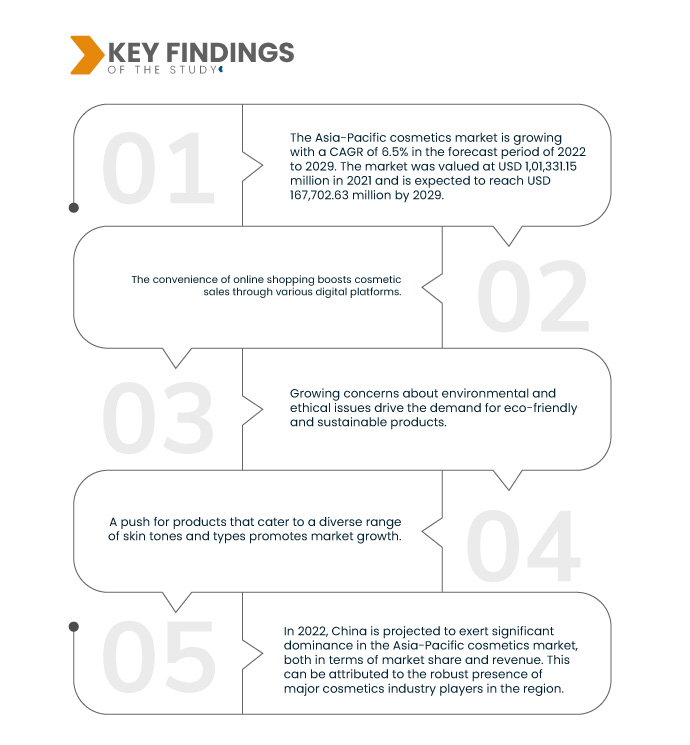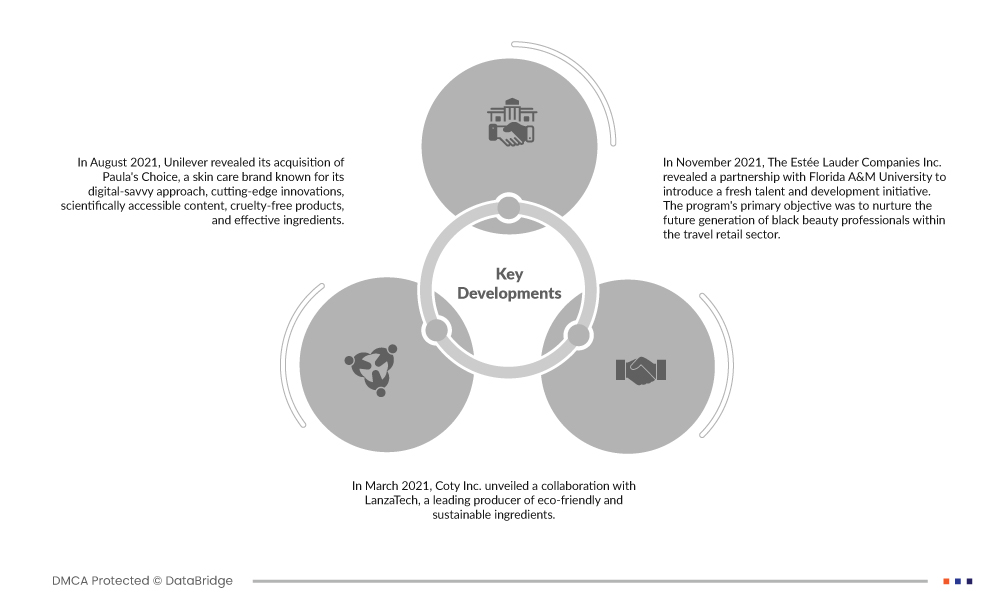The cosmetics market is witnessing remarkable innovations and trends. Sustainable and clean beauty products are gaining prominence, with consumers prioritizing eco-friendly and ethical choices. Advanced technology, such as augmented reality in beauty apps, is transforming the consumer experience. Personalization is on the rise, offering tailor-made products to cater to individual needs. Inclusivity and diversity are shaping product offerings, reflecting a broader range of skin tones and types. Overall, the cosmetics industry is evolving to meet evolving consumer preferences and sustainability concerns while embracing technological advancements.
Access Full Report @ https://www.databridgemarketresearch.com/fr/reports/asia-pacific-cosmetics-market
Data Bridge Market Research analyses that the Asia-Pacific Cosmetics Market is growing with a CAGR of 6.5% in the forecast period of 2022 to 2029. The market was valued at USD 1,01,331.15 million in 2021 and is expected to reach USD 167,702.63 million by 2029. Expanding cosmetics brands into new markets and regions spurs industry growth by unlocking fresh consumer bases, boosting sales, and diversifying revenue streams, ultimately broadening the industry's global footprint.
Key Findings of the Study
Rising disposable income is expected to drive the market's growth rate
Rising disposable income directly correlates with increased consumer spending capacity for cosmetics. With more money at their disposal, consumers are inclined to allocate a portion towards personal grooming and appearance enhancement. This economic empowerment enables them to explore a wider range of products and invest in higher-quality or premium cosmetics, fueling market growth. The cosmetics industry benefits from the positive correlation between disposable income and consumer demand for beauty and skincare products.
Report Scope and Market Segmentation
|
Report Metric
|
Details
|
|
Forecast Period
|
2022 to 2029
|
|
Base Year
|
2021
|
|
Historic Years
|
2020 (Customizable to 2014-2019)
|
|
Quantitative Units
|
Revenue in USD Million, Volumes in Units, Pricing in USD
|
|
Segments Covered
|
Product Type (Skin Care, Hair Care, Make Up, Fragrances, Others), Nature (Inorganic, Organic), Form (Creams and Gels, Lotions, Sprays, Solid and Others), Category (Mass Product, Premium Product, Professional Product), Packaging Type (Bottles and Jars, Tubes, Containers, Pumps and Dispensers, Sticks, Aerosol Cans, Pouches, Blisters and Strip Packs and Others), Distribution Channel (Offline and Online), End-User (Women, Men and Kids)
|
|
Countries Covered
|
China, Japan, India, South Korea, Singapore, Malaysia, Australia, Thailand, Indonesia, Philippines, Rest of Asia-Pacific (APAC) in the Asia-Pacific (APAC).
|
|
Market Players Covered
|
Unilever (U.K.), L'Oreal S.A. (France), Shiseido Company, Limited (Japan), The Estée Lauder Companies (U.S.), Procter & Gamble (U.S.), Kao Corporation (Japan), Colgate-Palmolive Company (U.S.), Oriflame Cosmetics Global SA (Luxembourg), Beiersdorf AG (Germany), Johnson & Johnson Services, Inc. (U.S.), Amorepacific (South Korea), Coty Inc. (U.S.), AVON PRODUCTS (U.K.), Revlon, Inc. (U.S.), The Body Shop International Limited (U.K.)
|
|
Data Points Covered in the Report
|
In addition to the market insights such as market value, growth rate, market segments, geographical coverage, market players, and market scenario, the market report curated by the Data Bridge Market Research team includes in-depth expert analysis, import/export analysis, pricing analysis, production consumption analysis, and consumer behaviour.
|
Segment Analysis:
The Asia-Pacific cosmetics market is segmented based on product type, nature, form, category, packaging type, distribution channel and end-user.
- On the basis of product type, the Asia-Pacific cosmetics market is segmented into skin care, hair care, fragrances, make up and others.
- On the basis of nature, the Asia-Pacific cosmetics market is segmented into organic and inorganic.
- On the basis of form, the Asia-Pacific cosmetics market is segmented into creams and gels, lotions, sprays, solid and others.
- On the basis of category, the Asia-Pacific cosmetics market is segmented into mass product, premium product and professional product.
- On the basis of packaging type, the Asia-Pacific cosmetics market is segmented into bottles and jars, tubes, containers, pouches, sticks, pumps and dispensers, blisters and strip packs, aerosol cans and others.
- On the basis of distribution channel, the Asia-Pacific cosmetics market is segmented into offline and online.
- On the basis of end-user, the Asia-Pacific cosmetics market is classified into women, men and kids.
Major Players
Data Bridge Market Research recognizes the following companies as the Asia-Pacific cosmetics market players in Asia-Pacific cosmetics market are Unilever (U.K.), L'Oreal S.A. (France), Shiseido Company, Limited (Japan), The Estée Lauder Companies (U.S.), Procter & Gamble (U.S.), Kao Corporation (Japan), Colgate-Palmolive Company (U.S.).
Market Developments
- In August 2021, Unilever revealed its acquisition of Paula's Choice, a skin care brand known for its digital-savvy approach, cutting-edge innovations, scientifically accessible content, cruelty-free products, and effective ingredients. This strategic move involved integrating Paula's Choice into Unilever's product lineup, extending its reach to a broader audience. This decision aligned with Unilever's strategic goal of expanding its range of high-quality skin care products within the cosmetics market.
- In March 2021, Coty Inc. unveiled a collaboration with LanzaTech, a leading producer of eco-friendly and sustainable ingredients. Together, they pledged to invest in incorporating sustainable ethanol, derived from the capture of carbon emissions, into their fragrance offerings. This strategic alliance reinforced Coty's commitment to creating environmentally responsible and sustainable products in the market.
- In November 2021, The Estée Lauder Companies Inc. revealed a partnership with Florida A&M University to introduce a fresh talent and development initiative. The program's primary objective was to nurture the future generation of black beauty professionals within the travel retail sector. This initiative exemplified their dedication to promoting racial equity and facilitated their collaboration with Florida A&M University to establish a unique internship and scholarship program.
Regional Analysis
Geographically, the countries covered in the Asia-Pacific cosmetics market report are China, Japan, India, South Korea, Singapore, Malaysia, Australia, Thailand, Indonesia, Philippines, Rest of Asia-Pacific (APAC) in the Asia-Pacific (APAC).
As per Data Bridge Market Research analysis:
China is expected to dominate the in Asia-Pacific cosmetics market the forecast period 2022-2029
In 2022, China is projected to exert significant dominance in the Asia-Pacific cosmetics market, both in terms of market share and revenue. This can be attributed to the robust presence of major cosmetics industry players in the region. China's growing middle-class population, increasing urbanization, and changing consumer preferences contribute to the sector's expansion, making it a key driver in the regional cosmetics market's success.
For more detailed information about the Asia-Pacific cosmetics market report, click here – https://www.databridgemarketresearch.com/fr/reports/asia-pacific-cosmetics-market














